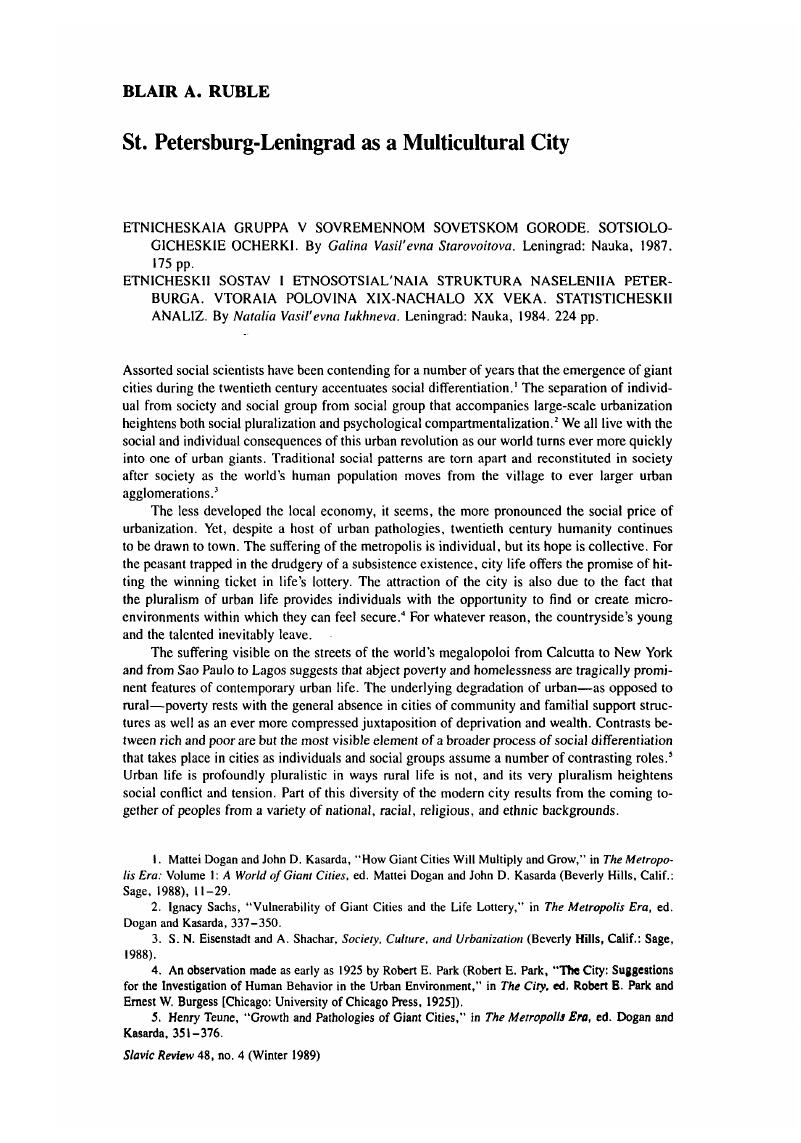Article contents
St. Petersburg-Leningrad as a Multicultural City
Published online by Cambridge University Press: 27 January 2017
Abstract

- Type
- Review Articles
- Information
- Copyright
- Copyright © Association for Slavic, East European, and Eurasian Studies. 1989
References
1. Dogan, Mattei and Kasarda, John D., “How Giant Cities Will Multiply and Grow,” in The Metropolis Era: Volume 1: A World of Giant Cities, ed. Dogan, Mattei and Kasarda, John D. (Beverly Hills, Calif.: Sage, 1988), 11–29 Google Scholar.
2. Ignacy Sachs, “Vulnerability of Giant Cities and the Life Lottery,” in The Metropolis Era, ed.Dogan and Kasarda, 337–350.
3. Eisenstadt, S. N. and Shachar, A., Society, Culture, and Urbanization (Beverly Hills, Calif.: Sage, 1988)Google Scholar.
4. An observation made as early as 1925 by Park, Robert E. (Robert E. Park, “Ttie City: Suggestionsfor the Investigation of Human Behavior in the Urban Environment,” in The City, ed. Park, Robert B. and Burgess, Ernest W. [Chicago: University of Chicago Press, 1925])Google ScholarPubMed.
5. Henry Teune, “Growth and Pathologies of Giant Cities,” in The Metropolis Era, ed. Dogan and Kasarda, 351–376.
6. See, for example, Glazer, Nathan and Moynihan, Daniel Patrick, eds., Ethnicity, Theory and Experience (Cambridge: Harvard University Press, 1975 Google Scholar; and Olorunsola, Victor and Rothchild, Donald, eds., Stateversus Ethnic Claims: African Policy Dilemmas (Boulder, Colo.: Westview, 1983)Google Scholar.
7. Korel', Ludmila Vasil'evna, Peremeshcheniia naseleniia mezhdu gorodom i selom v usloviiakh urbanizatsii (Leningrad: Nauka, 1987, 60–61 Google Scholar.
8. Starovoitova, G. V., Etnicheskaia gruppa v sovremennom sovetskom gorode. Sotsiologicheskieocherki (Leningrad: Nauka, 1987), 4 Google Scholar.
9. Korel', Peremeshcheniia naseleniia, 33.
10. See, for example, such works as Iu. Bromlei, “Etnicheskie protsessy v SSSR,” Kommunist, 1983, no. 5 (March), 56–64; O. I. Shkaratan, “Peremeny v sotsial'nom oblike gorozhan” in Sovetskaia sotsiologiia, Institut sotsiologicheskikh issledovanii AN SSSR (Moscow: Nauka, 1982) 2: 39–52; and the contributionsappearing in Stepanian, T. A. and Karypkulov, A. K., eds., InternatsionaVnoe i natsional'noe v sotsialisticheskomobraze zhizni sovelskogo naroda (Frunze: Kirgyzstan, 1982 Google Scholar.
11. Drobizheva, L. M., “Les aspects socio-psychologiques des relations inter-ethniques en URSS” in Multilingualism: Aspects of Interpersonal and Intergroup Communication in Pluricultural Societies. Materialsfor the Soviet-Belgian Symposium, Brussels, March 13–15, 1986, ed. Arutiunian, Iu. V. (Moscow: Institute of Ethnography, USSR Academy of Sciences, 1986), 19–23 Google Scholar; L. M. Drobizheva, “Les traits communset les particularités nationales du mode de vie des peuples sovietiques,” in Multilingualism, ed. Iu. V.Arutiunian, 32–46; and L. M. Drobizheva, “The Role of Ethnicity in Modern Societies: The Ethnic in theCulture and Self-Awareness of People,” paper prepared for the Third Symposium on Ethnicity of theU.S.-U.S.S.R. Binational Commission on Ethnology and Anthropology, Princeton, N.J., December 1986.
12. See, for example, Shkaratan, O. I., “Vvedenie,” in EtnosotsiaVnye problemy goroda, ed. Shkaratan, O.I. (Moscow: Nauka, 1986, 5–11 Google Scholar; and Kasperovich, G. I., Migralsiia naseleniia v gorod i etnicheskie protsessy (na materialakh issledovaniia gorodskogo naseleniia BSSR) (Minsk: Nauka i tekhnika, 1985, 3–14 Google Scholar.
13. Subbotin, La. A., “Narody i ikh rasselenie: migratsiia,” in SotsiaV no-kul'turnyi oblik sovetskikhnatsii. Po resul'tatam etnosotsiologicheskogo issledovaniia, ed. Arutiunian, Iu. V. and Bromlci, Iu. V. (Moscow: Nauka, 1986, 16–32 Google Scholar.
14. See, for example, Rabinovich, M. G., “Gorod i traditsionnaia narodnaia kul'tura,” Sovetskaia etnografiia, 1980, no. 4, 12–24 Google Scholar; Myl'nikov, A. S., “Etnokul'turnaia rol’ goroda v period stanovleniia natsii,” Sovetskaia etnografiia, 1981, no. 1, 134–137 Google Scholar; Rabinovich, M. G. and Shmeleva, M.N., “K etnograficheskomyizucheniiu goroda,” Sovetskaia etnografiia, 1981, no. 3, 23–34 Google Scholar; Rabinovich, M. G., “Kopredeleniiu poniatiia ‘gorod’ (v tseliakh etnograficheskogo izucheniia),” Sovetskaia etnografiia, 1983, no. 3, 19–24 Google Scholar; M. G., Rabinovich and M. N., Shmeleva, “Gorod i etnicheskie protsessy (iz opyta etnograficheskogoizucheniia vostochnoslavianskikh gorodov),” Sovetskaia etnografiia, 1984, no. 2, 3–14 Google Scholar; O. I.Shkaratan, ed., Etnosotsial'nye problemy goroda; and Pain, E. A., “Sistema territorial'nykh obshchnostei iee rol’ v formirovanii i vosproizvodstve etnokul'turnykh traditsii v usloviiakh urbanizatsii,” Sovetskaia etnografiia, 1987, no. 1, 1–24.Google Scholar
15. Starovoitova, G. V., “K issledovaniiu etnopsikhologii gorodskikh zhitelei (po materialam oprosanaseleniia trekh gorodov Tatarskoi ASSR),” Sovetskaia etnografiia, 1976, no. 3, 45–56 Google Scholar; and O. I.Shkaratan, ed., Etnosotsial'nye problemy goroda.
16. O. I. Shkaratan, “Vvedenie,” and “Peremeny v sotsial'nom oblike gorozhan,” in Etnosotisial'nyeproblemy goroda, ed. O. I. Shkaratan.
17. Rorlich, Azade-Ayse, The Volga Tatars: A Profile in National Resilience (Stanford, Calif.: HooverInstitution Press, 1986), 172–173 Google Scholar.
18. Starovoitova, G. V., “K issledovaniiu tatarskoi etnodispersnoi gruppy v naselenii Peterburga-Leningrada,” Sovetskaia etnografiia, 1980, no. 1, 34–45 Google Scholar. Similar data and argumentation may be found inG. V. Starovoitova, “Etnodispersnaia gruppa v sovremennon sovetskom gorode (na materialakh issledovaniiatatary v Leningrade)” Einosotsial'ny problemy goroda, ed. O. I. Shkaratan, 192–275.
19. G. V. Starovoitova, Etnicheskaia gruppa v sovremennom sovetskom gorode, 50–51.
20. Ibid., 53–54.
21. Ibid., 147.
22. Ibid., 55–58.
23. Ibid., 63–77.
24. Ibid., 37–50.
25. Ibid., 40.
26. Ibid., 45.
27. Ibid.
28. Ibid., 308.
29. Ibid., 124–148.
30. Ibid., 78–93. Starovoitova views the process of adaptation to the Slavic Leningrad environment asone of internationalization rather than assimilation: Knowledge and absorption of Russian culture, norms ofbehavior, and language need not signal an abandonment of previous cultural commitments.
31. lukhneva, N. V., Etnicheskii sostav i etnosotsial'naia struktura naseleniia Peterburga. Vtoraiapolivina XlX-nachalo XX veka. Statisticheskii analiz (Leningrad: Nauka, 1984 Google Scholar.
32. Ibid., 3.
33. Ibid., 129–163.
34. Ibid., 34–79.
35. Ibid., 12.
36. Leningrad iLeningradskaia oblast’ vtsifrakh. Statisticheskii sbornik (Leningrad: Lenizdat, 1974), 19; Narodnoe khoziaistvo Leningrada i Leningradskoi oblasti v desiatoi piateletke. Statisticheskii sbornik (Leningrad: Lenizdat, 1981), 24–25.
37. N. V. lukhneva, Etnicheskii sostav i etnosotsial'naia struktura naseleniia Peterburga, 129–141.
38. Ibid., 207–215.
39. Ibid., 200–206.
- 1
- Cited by


